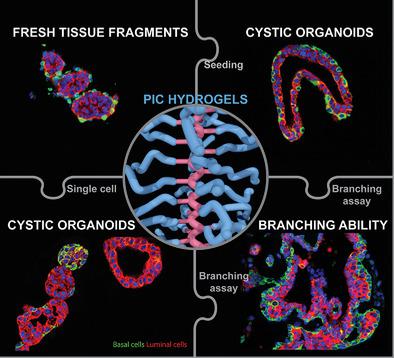Our official English website, www.x-mol.net, welcomes your
feedback! (Note: you will need to create a separate account there.)
Polyisocyanide Hydrogels as a Tunable Platform for Mammary Gland Organoid Formation
Advanced Science ( IF 14.3 ) Pub Date : 2020-07-26 , DOI: 10.1002/advs.202001797 Ying Zhang 1, 2 , Chunling Tang 2 , Paul N Span 2 , Alan E Rowan 3 , Tilly W Aalders 4 , Jack A Schalken 4 , Gosse J Adema 2 , Paul H J Kouwer 1 , Mirjam M P Zegers 5 , Marleen Ansems 2
Advanced Science ( IF 14.3 ) Pub Date : 2020-07-26 , DOI: 10.1002/advs.202001797 Ying Zhang 1, 2 , Chunling Tang 2 , Paul N Span 2 , Alan E Rowan 3 , Tilly W Aalders 4 , Jack A Schalken 4 , Gosse J Adema 2 , Paul H J Kouwer 1 , Mirjam M P Zegers 5 , Marleen Ansems 2
Affiliation

|
In the last decade, organoid technology has developed as a primary research tool in basic biological and clinical research. The reliance on poorly defined animal‐derived extracellular matrix, however, severely limits its application in regenerative and translational medicine. Here, a well‐defined, synthetic biomimetic matrix based on polyisocyanide (PIC) hydrogels that support efficient and reproducible formation of mammary gland organoids (MGOs) in vitro is presented. Only decorated with the adhesive peptide RGD for cell binding, PIC hydrogels allow MGO formation from mammary fragments or from purified single mammary epithelial cells. The cystic organoids maintain their capacity to branch for over two months, which is a fundamental and complex feature during mammary gland development. It is found that small variations in the 3D matrix give rise to large changes in the MGO: the ratio of the main cell types in the MGO is controlled by the cell–gel interactions via the cell binding peptide density, whereas gel stiffness controls colony formation efficiency, which is indicative of the progenitor density. Simple hydrogel modifications will allow for future introduction and customization of new biophysical and biochemical parameters, making the PIC platform an ideal matrix for in depth studies into organ development and for application in disease models.
中文翻译:

多异氰化物水凝胶作为乳腺类器官形成的可调平台
在过去的十年中,类器官技术已发展成为基础生物学和临床研究的主要研究工具。然而,对不明确的动物源性细胞外基质的依赖严重限制了其在再生和转化医学中的应用。在这里,提出了一种基于多异氰化物(PIC)水凝胶的明确的合成仿生基质,该基质支持在体外有效且可重复地形成乳腺类器官(MGO)。 PIC 水凝胶仅用用于细胞结合的粘附肽 RGD 修饰,允许从乳腺碎片或纯化的单个乳腺上皮细胞形成 MGO。囊性类器官在两个多月内保持分支能力,这是乳腺发育过程中的一个基本且复杂的特征。研究发现,3D 矩阵的微小变化会引起 MGO 的巨大变化:MGO 中主要细胞类型的比例由细胞-凝胶相互作用通过细胞结合肽密度控制,而凝胶硬度控制集落形成效率,它表示祖细胞密度。简单的水凝胶修饰将允许未来引入和定制新的生物物理和生化参数,使 PIC 平台成为深入研究器官发育和在疾病模型中应用的理想矩阵。
更新日期:2020-09-23
中文翻译:

多异氰化物水凝胶作为乳腺类器官形成的可调平台
在过去的十年中,类器官技术已发展成为基础生物学和临床研究的主要研究工具。然而,对不明确的动物源性细胞外基质的依赖严重限制了其在再生和转化医学中的应用。在这里,提出了一种基于多异氰化物(PIC)水凝胶的明确的合成仿生基质,该基质支持在体外有效且可重复地形成乳腺类器官(MGO)。 PIC 水凝胶仅用用于细胞结合的粘附肽 RGD 修饰,允许从乳腺碎片或纯化的单个乳腺上皮细胞形成 MGO。囊性类器官在两个多月内保持分支能力,这是乳腺发育过程中的一个基本且复杂的特征。研究发现,3D 矩阵的微小变化会引起 MGO 的巨大变化:MGO 中主要细胞类型的比例由细胞-凝胶相互作用通过细胞结合肽密度控制,而凝胶硬度控制集落形成效率,它表示祖细胞密度。简单的水凝胶修饰将允许未来引入和定制新的生物物理和生化参数,使 PIC 平台成为深入研究器官发育和在疾病模型中应用的理想矩阵。







































 京公网安备 11010802027423号
京公网安备 11010802027423号